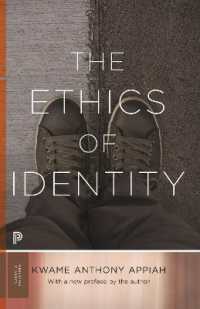- ホーム
- > 洋書
- > 英文書
- > Nature / Ecology
Full Description
From time immemorial people have been drawn to the beach to collect practical resources as well as mysterious objects that have fuelled myth and folklore - it is our inherent hunter-gatherer instinct. Whether you are a seasoned beachcomber, a casual visitor or an enthusiastic naturalist this book will satisfy your curiosity about the treasures found cast up on the beach strandline, be it a pretty seashell, a spent eggcase, a seaweed frond or an exotic ocean voyager. Every find has a story to tell and we aim to answer the questions that arise from each beachcombing discovery - what is it and where has it come from? Clear photographs and descriptions are accompanied by information about the natural history of the animals and plants you encounter. Even man-made debris can offer a fascinating introduction to the workings of the ocean and illustrate how items discarded in Africa or America can wash ashore on a British beach.The beach strandline is often overlooked as a wildlife habitat but is home to a unique community of flora and fauna, many found nowhere else. It is understudied and under threat, facing a variety of man-made problems.In this book you will find a comprehensive account of the animals and plants that make up this rich and ever-changing oasis of life in the otherwise harsh environment of the beach. The more we understand the delicate nature of the strandline the more we can do to nurture and protect it.But beware - beachcombing can be an addictive pleasure! Make sure you pack this book every time you visit the beach - there is always something new to discover, whether on a nocturnal strandline safari, making seaweed whistles or hunting minibeasts with pots and pooters. Emmerse yourself in the beachcombing experience; the wind in your face, the smell of salt spray, the roar of the ocean; it's an assault on the senses, the perfect tonic - and this book is your essential guide.
Contents
Acknowledgements 7Introduction 9 What is the strandline? 9 Where does the material come from? 9 What can we learn from what is found? 9 When is the best time for beachcombing? 11 Why are there multiple strandlines? 11 An extraordinary wildlife habitat 12 Threats 13 Kit list 14 Collecting and recording your finds 16 Keeping safe 19Beaches 21 Sandy beaches 21 Rocky or boulder beaches 22 Shingle beaches 22 Maerl beaches 23Seaweeds 25 Brown seaweeds 28 Green seaweeds 42 Red seaweeds 46Eelgrass 54Shells 57 Sandy shore 58 Bivalves 58 Gastropods 71 Rocky shore 75 Gastropods 75 Bivalves 81Eggcases and eggs 85 Mermaid's purses 85 Shark eggcases 88 Skate and ray eggcases 89 Eggs 94Invertebrates and their remains 97 Cuttlefish and squid 115 Crab moults 118 Other crustacean moults 125Carcasses, skulls and bones 127 Seabirds and their remains 127 Live strandings of cetaceans and turtles 135 Dead strandings of cetaceans and turtles 136 Marine mammal skeletal remains 143 Fish 147Ocean drifters 157 Driftwood 157 Sea beans 161 Jellyfish 171 Animals of the ocean's surface 177 Goose barnacles and associated animals 182 Exotic non-natives on litter 189Pebbles with a difference 197Marine and beach litter 201 Fishing litter 210 Shipping litter 226 Land-sourced litter 229 Sewage-related debris 233Strandline wildlife 235 Invertebrates 243 Birds 268 Mammals and amphibians 281 Strandline plants 285Glossary 296Photographic credits 297Further reading 298Index 299
-

- 電子書籍
- ママがほしいの【分冊】 12巻 ハーレ…
-

- 電子書籍
- 1年5組いきものがかり(6)






